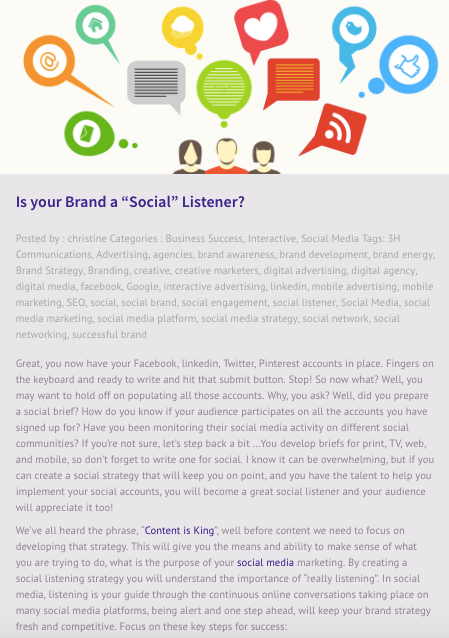

Posted by : christine Categories : Business Success, Interactive, Social Media Tags: 3H Communications, Advertising, agencies, brand awareness, brand development, brand energy, Brand Strategy, Branding, creative, creative marketers, digital advertising, digital agency, digital media, facebook, Google, interactive advertising, linkedin, mobile advertising, mobile marketing, SEO, social, social brand, social engagement, social listener, Social Media, social media marketing, social media platform, social media strategy, social network, social networking, successful brand
Great, you now have your Facebook, linkedin, Twitter, Pinterest accounts in place. Fingers on the keyboard and ready to write and hit that submit button. Stop! So now what? Well, you may want to hold off on populating all those accounts. Why, you ask? Well, did you prepare a social brief? How do you know if your audience participates on all the accounts you have signed up for? Have you been monitoring their social media activity on different social communities? If you’re not sure, let’s step back a bit …You develop briefs for print, TV, web, and mobile, so don’t forget to write one for social. I know it can be overwhelming, but if you can create a social strategy that will keep you on point, and you have the talent to help you implement your social accounts, you will become a great social listener and your audience will appreciate it too!
We’ve all heard the phrase, “”, well before content we need to focus on developing that strategy. This will give you the means and ability to make sense of what you are trying to do, what is the purpose of your social media marketing. By creating a social listening strategy you will understand the importance of “really listening”. In social media, listening is your guide through the continuous online conversations taking place on many social media platforms, being alert and one step ahead, will keep your brand strategy fresh and competitive. Focus on these key steps for success:
1. Who is Your Target Audience(s) and which social platforms to use: Once you have determined who your audience is, it’s imperative to focus on where to engage your audience online. As said earlier, don’t just start opening accounts to social platforms that don’t reflect your brand or your target audience. This could have a negative impact on your marketing campaign and diminish your brand. Research where your audience is already active, capture this data and customize your social media accounts to adapt to your audiences’ socializing habits.
2. Identify the influencers: These are the people who follow, share or friend you. They are more important than the actual volume of traffic. Determining who your influencers are will make all the difference in your listening strategy and ultimately how affectively you have captured the information and affectively communicated with your target audience.
3. What are the keywords and trends in your social world: You want to validate the topics and conversations that matter most to your brand and document them as potential keywords. You then need to determine through social listening if these keywords reflect or resemble the “social speak” that your audience is interested in. Keywords should reflect what’s important to your brand. However, you need to compare your word selection to that of what is being used by your audience. Don’t think traditional marketing here, or specific naming conventions used throughout the industry. Look for real words, used by real people. This approach will help you communicate more successfully with your target audience.
So now that you have your social strategy in place and the talent in place. You can now start selecting your accounts and write content. Make sure you keep it up-to-date and current with specific topics that tie into your brand and relate to your social users…use your customer’s speak, not marketing lingo and always keep it fresh. This will keep your brand on target with your audience…You also need to take a pulse on your brand as it stands today, consistently monitoring social sites that talk about your brand, making sure that your online reputation is strong, active and fresh.
Also, keep in mind that socializing on the Internet is not limited to the traditional social media platforms. Don’t forget about the community blogs, forums and posts, these areas all require your focus and interaction keeping up with conversations across the web to maintain a strong brand presence online and off. Keeping up with what your customers are saying about your product or service will keep you informed and honest about your brand. Yes, this is time consuming, but in the end, the best investment for you to apply, and to keep your brand honest and on target.
Now you are ready to get back to your keyboard and write, and make your Brand a “Social” listener.
Let me know how your social listening strategy has worked for you (do’s / don’ts) and links you might want to share with us pertaining to this topic. Thanks for listening.
Author: Christine Brown
Christine has been delivering creative campaigns for over 19 years, formally trained in the visual arts, graphic design, and interactive media, focusing on engaged online experiences with some of the world’s most recognized brands.
